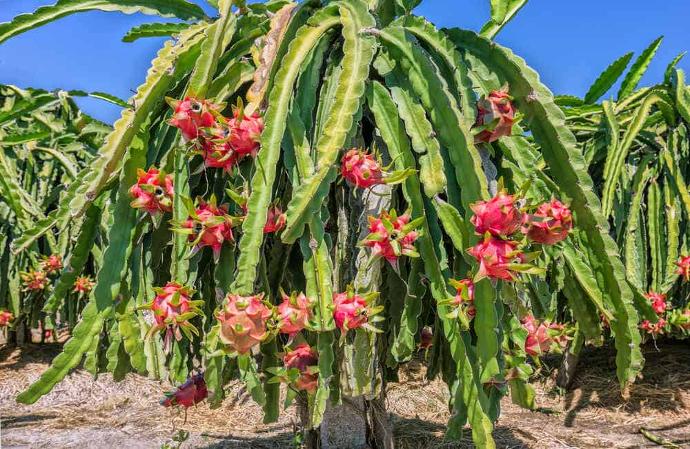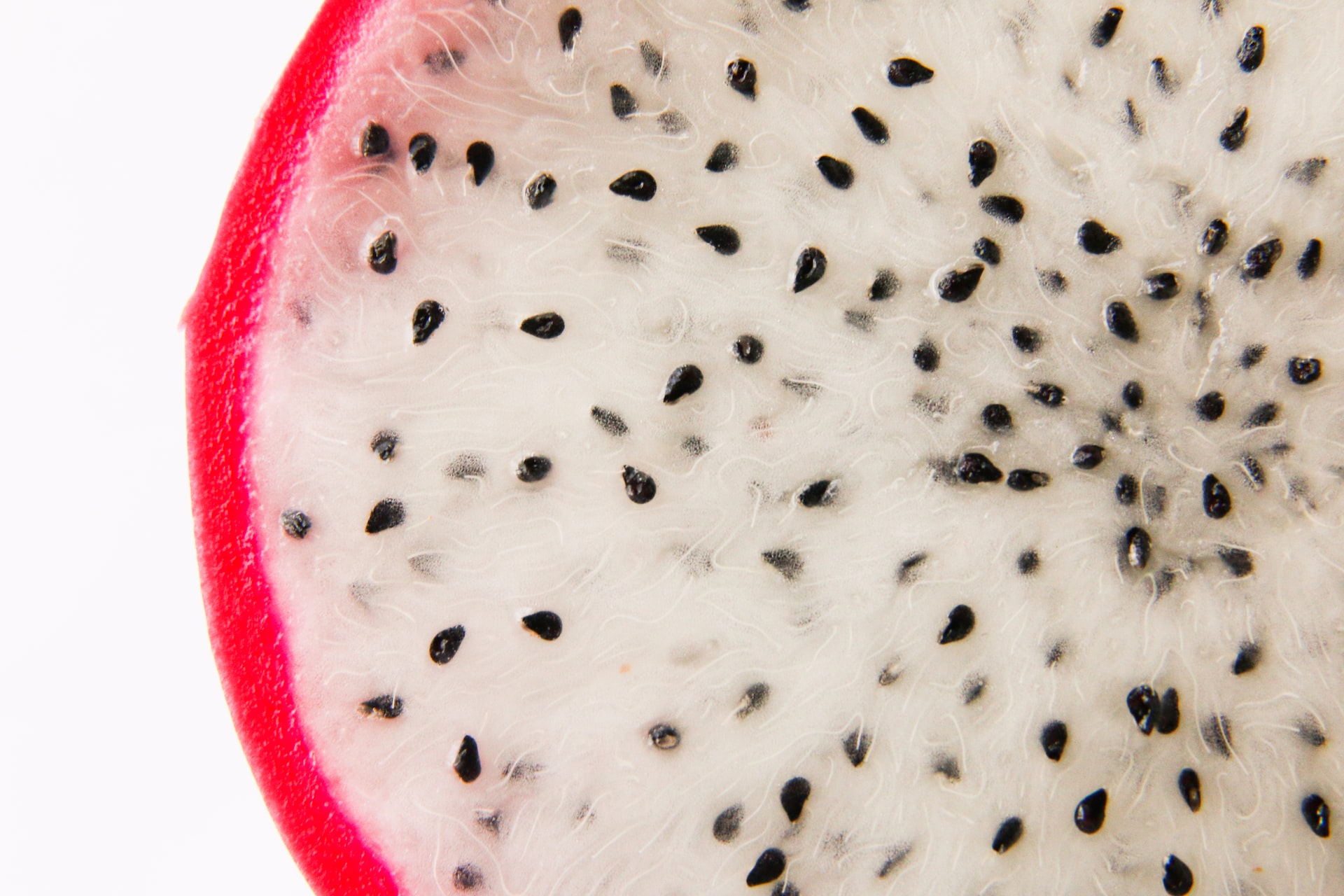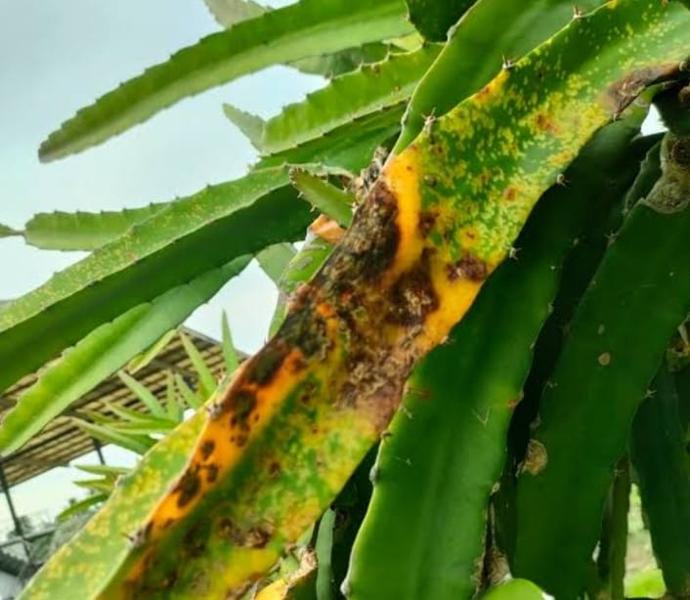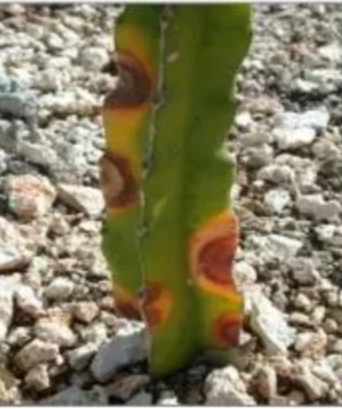Dragon Fruit Plant
Dragon Fruit vines, with fast growth, prefer well-drained soil and full sun to partial shade. With moderate moisture needs, Dragon Fruit plants produce edible fruits and are cultivated for their unique appearance.

Habit
Vine
Height
3 to 5 m
Growth
Fast
Soil
Well Drained, sandy loam
Shade
Full Sun to Partial Shade
Moisture
Moderate
Edible
Yes
Medicinal
Yes
Origin
Central America
Climatic Condition
Tropical, subtropical
Temperature (°)
18 to 35
Humidity (%)
50 to 80
Potting media
Sandy loam
Fertilizers
High phosphorus, potassium
Watering
Moderate
Plant Weight
300 to 800 g
Flowering Time
Summer, Autumn
Soil Ph level
5.5 to 7.0
Water Ph level
6.0 to 7.0
Soil EC
0.4 to 1.5
Yield Per Plant
3–4 dragon fruit plants can yield around 15 kg of fruit per year
NPK ratio
5:10:10
life Span
15-20 yrs
Health Benefits
Rich in fiber, vitamin C, improves digestion.
Suggested Grow Media or Potting Mix ?
40% cactus mix, 30% perlite, 30% sand
Suggested Fertigation/Fertilizers
Fertilize every 4 weeks with a balanced, low-nitrogen fertilizer.
Common Diseases and Remedies
Anthracnose, Root rot, Soft rot, Wilt, Stem canker
Sunken lesions appear with a dark centre and reddish brown margins. And causes the stem to rot.
Remove the effected part and Avoid more watering. Cinnamon fungicide can be sprayed in 2 weeks of interval.
HEALTH BENEFITS
(White-Fleshed & Red-Fleshed)
o Rich in antioxidants (Vitamin C, flavonoids, betalains)
o Boosts immunity
o Aids digestion (high in fiber, promotes gut health)
o Supports heart health (lowers bad cholesterol, improves circulation)
o Helps regulate blood sugar
What Is A Dragon Fruit Tree?
The dragon fruit plant, also known as pitaya or pitahaya, is a type of tropical cactus native to Central and South America. Produces vibrant, exotic fruits with a unique appearance and taste. The plant typically has extensive spiky vines and large flowers that bloom at night and are pollinated by nocturnal creatures such as bats and moths. Dragon fruit plants require warm temperatures, well-drained soil, and plenty of sunlight to grow. The dragon fruit plant, scientifically known as Hylocereus and Selenicereus, belongs to the Cactaceae family. Here are some important points about dragon fruit plants.

What are the different types of dragon fruit plant?
1. Hylocereus undatus:-
Also known as white-fleshed dragon fruit, it has pink/red skin and white flesh. It's sweet and a little sour.
2. Hylocereuscostaricensis:-
Well known as the red-fleshed dragon fruit, it is characterized by its red skin and bright red flesh. It is sweeter and juicier than the white-fleshed variety.
3. Hylocereus megalanthus:-
Known as the yellow dragon fruit, it has yellow skin and white flesh. They are typically sweeter, more tart, and have a more tropical flavor than white-fleshed varieties.
4. Hylocereus Polyrhizus: -
Also known as Vietnamese dragon fruit, this variety has red skin and flesh.
5. Selenicereus megalanthus:-
Also known as "yellow dragon fruit" or "yellow pitaya", it has yellow skin and white flesh.

How To Care For Dragon Fruit Plant?
1. Location
Dragon fruit plants, also known as pitayas or pitahayas, are native to Central and South America, particularly regions such as Mexico, Guatemala, Costa Rica, and Colombia. They are also found in parts of Asia, including Vietnam, Thailand, the Philippines, and Taiwan. These plants thrive in warm, tropical climates with well-draining soil and ample sunlight. In cultivation, they can be grown outdoors in suitable climates or indoors in containers in regions where the climate is not conducive to outdoor growth.
2. Sunshine
Dragon fruit plants thrive in full sunlight. They require at least 6 hours of direct sunlight per day to grow and produce fruit optimally. Placing them in a location where they can receive ample sunlight ensures proper photosynthesis, which is essential for plant growth and fruit development. Inadequate sunlight can lead to leggy growth, decreased fruit production, and overall poor health of the plant. Therefore, it's important to position dragon fruit plants in a sunny spot, whether grown outdoors or indoors near a bright window.
3. Soil
Dragon fruit plants thrive in well-draining soil with a pH level ranging from 6 to 7. They prefer soil that is loose, sandy, or loamy, allowing water to drain freely and preventing waterlogging, which can lead to root rot. A mix of sandy or loamy soil with organic matter such as compost or well-rotted manure helps provide essential nutrients while maintaining good drainage. Additionally, adding perlite or coarse sand to the soil mixture can further improve drainage. Overall, selecting the right soil for dragon fruit plants ensures proper root development, nutrient uptake, and overall plant health.
4. Hydration
Proper hydration is very important for the health and growth of your dragon fruit plant. These plants require regular watering, especially during the growing season, which is usually spring and summer. However, it is important not to overwater, as overwatering can lead to root rot and other problems.

5. Nourishment
Dragon fruit plants benefit from regular fertilization, especially during the growing season (spring and summer). Use a balanced fertilizer specifically formulated for cacti and succulents, or a fertilizer with a low nitrogen content. Apply fertilizer according to the manufacturer's instructions to avoid over-fertilizing, which can cause excessive vegetative growth at the expense of fruit production. In addition to primary nutrients (nitrogen, phosphorus, and potassium), dragon fruit plants require micronutrients such as iron, magnesium, and calcium for healthy growth. Make sure the fertilizer you use contains these essential micronutrients or supplements with micronutrient-rich supplements if needed. Incorporating organic materials, such as compost and well-rotted manure, into the soil provides additional nutrients and improves soil structure. This helps improve nutrient retention, promotes beneficial microbial activity in the soil, and supports overall plant health.
6. Issues
Overwatering or poorly drained soil can cause root rot, which can cause the roots to become mushy and rot. This can cause leaves to wilt, yellow, fall, and reduce the overall health of the plant. Dragon fruit plants may be susceptible to pests such as scale insects, mealybugs, and spider mites. These pests feed on plant tissue, damage leaves and stems, and can transmit disease. Diseases such as fungal infections (e.g. anthracnose, stem rot) and bacterial infections can affect dragon fruit plants, especially in damp or damp conditions. Symptoms may include black spots on stems and fruit, wilting, and decreased overall plant vigor. Insufficient or unbalanced nutrients in the soil can cause nutrient deficiencies in dragon fruit plants. The most common defects include yellowing of leaves (indicating nitrogen deficiency), stunted growth, and poor fruit development.
What are the benefits of the dragon fruit?
Contains both soluble and insoluble fiber, which promotes digestive health, regulates bowel movements, and reduces the risk of constipation. Dragon fruit is a good source of essential vitamins and minerals such as B vitamins, iron, calcium, and phosphorus, which are essential for various body functions such as bone health and energy metabolism. Dragon fruit is relatively low in calories but rich in nutrients, making it a nutritious choice for those looking to control weight while maintaining essential nutrients. Vitamin C in dragon fruit supports immune function, protects the body from infections and promotes healing. The fiber, antioxidants, and monounsaturated fats in dragon fruit may help reduce the risk of heart disease by lowering cholesterol and improving blood circulation.

FAQs about growing dragon fruit
1.What are the health benefits of dragon fruit?
Rich in antioxidants , Good Source of Vitamin C , Rich in dietary fibre, Low Calorie , Contains essential nutrients , May Help Improve Digestive Health, Potential anti-inflammatory properties.
2.How do you choose a ripe dragon fruit?
Colour , Consistency , Skin Appearance, Aroma , Weight
3.Can you grow dragon fruit at home?
Dragon fruit grows in tropical or subtropical climates. They need lots of sunlight and warmth to grow well. Plant dragon fruit in well-drained soil with a pH of 6 to 7 , You can improve soil drainage by adding sand or perlite. Dragon fruit can be grown from seeds, but propagation is often done by cuttings. While growing as a climbing cactus, plant the cuttings on a sturdy support structure such as a trellis or pole. Water your plants regularly, especially during the growing season. However, be careful not to overwater as dragon fruit is prone to root rot. Fertilize plants with a balanced fertilizer during the growing season to promote healthy growth and fruit production.
4.How do you eat dragon fruit?
Wash the dragon fruit under running water to remove dirt and debris from the skin. Pat dry with paper towel. Cut the dragon fruit in half lengthwise with a sharp knife. Inside you can see white or pink flesh with small black seeds scattered around. Dragon fruit can be eaten in many different ways. A common method is to scoop out the pulp with a spoon, similar to how you would eat a kiwi. Avoid eating the hard outer skin. You can leave the skin on and cut the pulp into cubes and scoop it out with a spoon, or you can simply peel off the skin and cut the pulp into cubes. Dragon fruit can be enjoyed alone as a refreshing snack or added to fruit salads, smoothie bowls, or desserts to add colour and flavour.Some people like to squeeze a little lime or lemon juice on the fruit to enhance the flavor, while others sprinkle with a pinch of salt or chili powder to give it a unique touch.
5.Are there any recepies that include dragon fruit?
1. Dragon Fruit Smoothie: Ingredients- dragon fruit (scooped from the skin), banana, Greek yogurt, milk (or coconut water), honey (optional). Directions: Mix all ingredients until smooth. Adjust sweetness with honey if necessary. Serve chilled.
2. Dragon Fruit Salad: Ingredients- Diced dragon fruit, diced pineapple, sliced strawberries, mint leaves, lime juice. Instructions: Mix all the fruits in a bowl. Pour lime juice over it and garnish with fresh mint leaves. Serve chilled.
3. Dragon Fruit Salsa: Ingredients: -Diced dragon fruit, diced mango, diced red onion, chopped cilantro, lime juice, salt, diced jalapeño (optional). Directions: Mix all ingredients in a bowl. Season to taste. Serve with tortilla chips or grilled fish.
4. Dragon Fruit Popsicles: Ingredients:- Mixed dragon fruit pulp, coconut water (or juice of your choice), diced fruit pieces (optional). Directions: Pour blended dragon fruit mixture into popsicle molds and add diced fruit if desired. Insert the popsicle stick and freeze until solid.
5. Dragon Fruit Sorbet: Ingredients:- Mixed dragon fruit pulp, sugar (optional), lime juice. Directions: Mix pureed dragon fruit with sugar and lime juice in a bowl. Pour the mixture into a shallow bowl and freeze, stirring occasionally until it reaches a sorbet-like consistency. Serve the balls in a bowl or bag.



